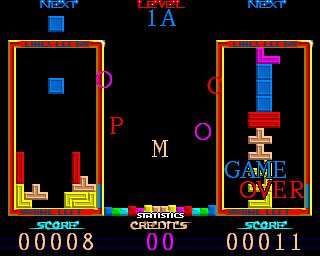Puyo Puyo is a puzzle game originally developed by Compile and first released in 1991. Its roots lie in the Madō Monogatari series, a first-person dungeon crawler featuring colorful, anime-style characters. While that origin may seem unrelated to falling block puzzle games, Compile used the same characters as the foundation for Puyo Puyo's visual identity, combining simple gameplay mechanics with a unique aesthetic.
The core concept of Puyo Puyo draws clear inspiration from Tetris, the 1984 phenomenon that popularized the falling block puzzle genre. But unlike Tetris, which is about fitting geometric shapes into lines, Puyo Puyo focuses on matching four or more blobs (called "puyos") of the same color. The twist is in the chain reactions: when a group disappears, the puyos above drop into place, potentially triggering new matches. Skilled players can create elaborate combos, punishing their opponents with "garbage puyos" that clutter the screen.
While the first arcade versions were successful in Japan, it was the 16-bit console ports that brought the game into homes. The SEGA Mega Drive version, released in 1992, is one of the most well-known early console versions. It was fast, visually clear, and included a fun story mode where the player faced off against a series of quirky opponents. In North America and Europe, it was rebranded as Dr. Robotnik’s Mean Bean Machine for SEGA (featuring the characters from Sonic), and Kirby’s Avalanche for the SNES, hiding the original Japanese characters behind familiar Western mascots. Despite the cosmetic changes, the gameplay remained faithful to the original Puyo Puyo formula.
What made Puyo Puyo stand out from other puzzle games of the time, including Tetris and its clones (see Tetris Pro or Super Tetris), was its emphasis on competitive play. It introduced a deeper layer of strategy, requiring speed, foresight, and planning. Matches became intense battles of wits and reflexes, especially in multiplayer mode, where counter-chains could turn the tide of the game in seconds.
The legacy of Puyo Puyo is massive. It spawned numerous sequels and spin-offs, both in Japan and internationally. The competitive multiplayer style it popularized laid the groundwork for many modern puzzle games. Titles like Candy Crush Saga owe a conceptual debt to Puyo Puyo, especially in their use of cascading matches and chain reactions, even if they simplify the mechanics for a broader audience.
At GamesNostalgia we decided to offer you the original Japanese version. Enjoy!












